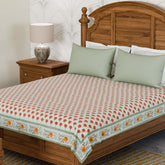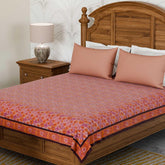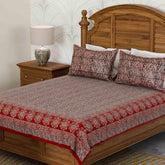Ceramic vs Porcelain Plates – Which One Should You Choose?

Dinnerware isn’t just about serving food; it sets the mood for every meal and makes your dining table look inviting. The right plates can make your meals look more appealing, feel easier to handle, and even last longer with everyday use.
When it comes to choosing the perfect dinnerware, the material plays a big role. Two of the most popular options you’ll come across are porcelain and ceramic plates.
At first glance, they might look quite similar, but there are some key differences between them in terms of strength, durability, appearance, and practicality.
In this blog, we’ll be comparing ceramic vs porcelain plates to help you understand what makes each unique — and which one might be the better fit for your home.
Quick Summary: Ceramic vs Porcelain Plates
Here’s a quick comparison to help you choose between ceramic and porcelain plates:
| Features | Ceramic Plates | Porcelain Plates |
|---|---|---|
| Material | Made from natural clay, fired at moderate temperatures | Made from refined clay, fired at much higher temperatures |
| Durability | Durable but slightly porous | Denser, stronger, and more long-lasting |
| Appearance & Style | Available in many colours, glazes, and textures | Smooth, glossy, and elegant white finish |
| Weight | Heavier | Lighter yet stronger |
| Best Use | Perfect for everyday dining | Ideal for special occasions and long-term use |
| Cost | Budget-friendly and affordable | Premium and higher priced |
In short:
-
Ceramic plates – Great for variety, style, and a pocket-friendly option for daily use.
-
Porcelain plates – Best for those who want something durable, elegant, and refined for special meals or long-term use.
Also Read: 12 Easy Pot Decoration Ideas to Style Your Home & Garden
What Are Ceramic Plates?

Ceramic is a broad category that covers several types of dinnerware, like earthenware, stoneware, and even porcelain itself. Ceramic plates are typically made from natural clay, shaped, and fired at moderate temperatures to achieve their sturdy form.
Here’s what makes them stand out:
-
Durability: Ceramic plates are slightly porous, which means they can chip or crack more easily if dropped. However, with proper care, they last well for everyday use.
-
Appearance: Available in a wide variety of colours, textures, and artistic designs, ceramic plates often have a glazed finish that adds shine and provides a layer of protection. They’re perfect for daily meals and creative table settings.
-
Weight: Usually heavier than porcelain, giving them a solid and grounded feel.
-
Cost: Ceramic plates are more budget-friendly compared to porcelain, making them a popular choice for families and casual dining.
Also, if you’re a fan of ceramics, don’t forget to check out our ceramic dinner sets online.
What Are Porcelain Plates?

Porcelain is a special type of ceramic made from highly refined clay, usually including kaolin, a mineral that gives it its signature smoothness and strength. These plates are fired at extremely high temperatures, which makes them denser, harder, and more durable than normal ceramics.
-
Appearance: Porcelain plates have a white, glossy, and smooth surface. Some are even slightly translucent, giving them that elegant, high-end look often seen in fine dining.
-
Durability: They’re strong, dense, and resistant to scratches, chips, and cracks, making them perfect for both everyday meals and special occasions.
-
Weight: Porcelain is thin and lightweight, which makes it easier to handle compared to heavier ceramic plates.
-
Cost: While porcelain plates are generally more expensive, their long-lasting quality makes them a worthwhile investment for your dining collection.
Ceramic vs Porcelain Plates: Key Differences
While both ceramic and porcelain belong to the same family, they differ in how they’re made, how strong they are, and how they perform in daily use. Let’s break it down:
1. Material & Firing Temperature
-
Ceramic Plates: Made from natural clay and fired at moderate temperatures, ceramic plates have a slightly porous texture. This makes them perfect for creative designs and colourful finishes, but also means they can be a bit more delicate.
-
Porcelain Plates: Crafted from refined clay (usually kaolin) and fired at very high temperatures, porcelain becomes harder, denser, and smoother. This process gives porcelain its signature glossy appearance and superior durability.
Also Read: 10 Surprising Benefits of Dream Catchers You Should Know
2. Strength & Durability

-
Ceramic Plates: Ceramic plates are sturdy enough for daily meals but can chip or crack if dropped or exposed to sudden temperature changes (like going from oven to fridge).
-
Porcelain Plates: Porcelain plates are stronger, denser, and more resistant to scratches, chips, and cracks. They can easily handle everyday wear and tear, making them ideal for long-term use.
Also, don’t miss out on our ceramic bowl sets; they’re great for everyday meals and look good with any dinner set.
3. Appearance & Style
-
Ceramic Plates: Ceramic plates come in a wide range of colours, textures, and designs, making them a great choice for people who love experimenting with their table setup.
-
Porcelain Plates: Porcelain plates, on the other hand, usually feature a smooth, white, and glossy finish. Their clean and elegant look adds a sophisticated touch to your dining table and is perfect for those who prefer something simple.
4. Usage
-
Ceramic Plates: Best suited for casual dining and everyday meals, ceramic plates are durable enough for regular use but may require a bit more care when handling.
-
Porcelain Plates: Porcelain plates are ideal for formal dining, restaurants, or anyone who wants dinnerware that lasts for years. Their durability and smooth finish make them equally suited for both daily use and special occasions.
5. Cost

-
Ceramic Plates: Ceramic plates are generally more affordable and budget-friendly, making them a great option for everyday use or for those who like changing dinnerware styles often. You get good quality and style without spending much.
-
Porcelain Plates: Porcelain plates are typically more expensive, but the higher price reflects their superior durability, smooth finish, and timeless elegance. If you’re looking for long-term value, porcelain is well worth the investment.
Also Read: 10 Cheap Decoration Ideas for Living Room Walls – 2025
Care Tips for Ceramic and Porcelain Plates

Whether you choose ceramic or porcelain plates, proper care helps keep them looking new and lasting longer. Here are a few simple tips to follow:
-
Wash gently: Always clean your plates with mild dish soap and a soft sponge. Avoid harsh detergents or abrasive cleaners.
-
Avoid metal scrubbers: Metal or hard scrub pads can scratch the glazed surface, dulling the shine over time.
-
Handle porcelain carefully: Even though porcelain plates are stronger, they can still break or chip if dropped, so handle them with care during washing and stacking.
-
Protect ceramic from temperature shocks: Don’t move ceramic plates directly from hot ovens or microwaves to cold surfaces (or vice versa), as sudden temperature changes can cause cracks.
Which One Should You Choose?
Your choice between ceramic vs porcelain plates ultimately depends on your needs, lifestyle, and budget. Both are excellent materials — it’s just about what fits your dining habits best.
-
Go for ceramic plates if you’re looking for affordable, colourful, and stylish tableware for everyday use. They’re easy to replace, available in countless designs, and perfect for adding character to your dining table. Just keep in mind that they may not be as long-lasting as porcelain.
-
Choose porcelain plates if you prefer durability, elegance, and a timeless look. They’re built to last for years, resist scratches and chips, and instantly make any meal feel more special. While they’re pricier than ceramic, they’re a worthwhile investment for anyone who values quality and refinement.
FAQs About Porcelain Vs Ceramic Plates
Q1. What is the main difference between ceramic and porcelain plates?
The main difference between ceramic and porcelain plates lies in the material and firing temperature. Ceramic plates are made from natural clay and fired at moderate heat, while porcelain plates are made from refined clay and fired at much higher temperatures.
Q2. Are porcelain plates better than ceramic?
That depends on your needs. Porcelain plates are more durable, lightweight, and elegant — ideal for long-term or formal use. Ceramic plates are more affordable and available in many colours and designs, perfect for casual everyday dining.
Q3. Can ceramic and porcelain plates go in the microwave or dishwasher?
Most ceramic and porcelain plates are microwave and dishwasher-safe, but it’s always best to check the manufacturer’s care label. Avoid sudden temperature changes or metal scrubbers to prevent damage.
Q4. Which is more expensive — ceramic or porcelain plates?
Porcelain plates are more expensive because of their refined material, high-temperature firing, and luxurious finish. Ceramic plates are more budget-friendly and great for those who like to switch up tableware often.
Q5. Do porcelain plates break easily?
Porcelain plates are quite strong and resistant to scratches and chips, but like any dinnerware, they can still break if dropped on hard surfaces. Handle them with care, especially during washing and stacking.









 https://eyaas.in/
https://eyaas.in/





Leave a comment
Please note, comments need to be approved before they are published.